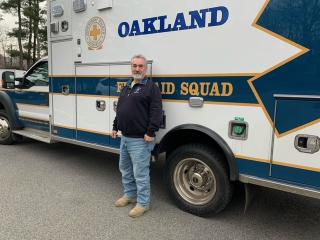Meet Oakland First Aid Squad Chief Jeff Marcheso

When there is an accident in Oakland where injuries are sustained or there is a medical event in a home or a calamity in a public place, a group of dedicated ambulance squad volunteers go out to give aid with an every-second-counts urgency.
Long-time First Aid Squad Chief Jeff Marcheso explains, “When an emergency call is made to either 911 or police dispatch, the first responders on duty are immediately alerted by page. Our response time to the emergency is five minutes in most cases.”
And while quick communication, first-responder training and ambulances are critical, the most important component in saving lives is the dedicated team of men and women who provide the first care to the injured.
Marcheso adds, “Calls come in night and day and call volumes can be heavy at times. We get calls for bad accidents, health problems, Covid emergencies, mental issues, drug and alcohol-related emergencies. Our team is trained to give aid, assess the needs of the injured and then we transport them to the hospital.”
Marcheso, a safety coordinator for Out Front Media, began our recent tour of the John Robert Walker Memorial First Aid Squad Building here in Oakland with a look at the two very impressive, shiny state-of-the art ambulances parked in the squad garage.
“Our first ambulance was a gift from Vivian and John Walker back in 1954,” he says. “In the years prior to that their son John suffered from leukemia and had to go to New York for weekly treatments. A ‘mother squad’ of neighbors formed to transport him. When their son passed away, the Walkers and other Oakland residents worked to organize Oakland’s first, first aid squad and first ambulance. They also raised the money to build the squad building in 1964 on land donated by the town.”
Oakland’s First Aid Squad has delivered emergency care to Oaklanders for 62 years. The medical care they rendered then has advanced greatly due to innovations in medicine and in equipment. And as Oakland’s squad grew in size and sophistication, layers of expertise were added to provide care for simple injuries and for the more life-threatening ones.
Today, our emergency medical technicians (EMT’s) are trained to give basic life support. They work side by side with the local hospital’s paramedics, who provide advanced life support.
Marcheso says, “When Interstate 287 came through Oakland, towns along its corridor formed agreements where each town has responsibility along the way. Oakland’s portion of 287 is from Exit 58 to Exit 55 southbound and from Exit 57 to Colonial Road northbound. That keeps us busy, especially lately with all the rain-related accidents we’ve had.
“The towns in our area also provide mutual support for each other in larger events that require multiple ambulances. That mutual support was only semi-organized in 1984 during the Muller Park shootings, where 20,000 people were involved. Today, MICOM, a sophisticated communication network, gives us the highly-organized capability to reach out for support to manage the crisis.”
The cost of providing a community like Oakland with this kind of high-level of emergency response, as you can imagine, is high. The upkeep of the building, the cost of an ambulance (near $200,000), cost of supplies, equipment, insurance and gear are not insignificant.
Marcheso states, “Oakland’s First-Aid Squad manages to provide its own funding with the help of the good people of Oakland who are very generous, even in this pandemic time. Our treasurer creates a budget each year together with input from our finance committee. With support from the Borough of Oakland, Valley Hospital and the people of Oakland, we manage to pay the costs.”
The greatest resource the squad has is its people. Historically, people of all ages in Oakland have volunteered to perform the duties of a first responder. It is their dedication that provides the service of saving our lives and the lives of our loved ones.
“Having the funding to operate is not our biggest challenge. The greatest challenge we have is getting and keeping our volunteers. Our crews are on duty at specific times and are called to aid in all kinds of situations, some of which can be hard to forget,” Marcheso says.
Oakland’s First Aid volunteers come from members of the community and from students in our high schools who volunteer for low-level tasks and who grow into fully-trained and dedicated first responders. Some of them stay with the squad for many years and others go on into the medical professions. Oakland’s Squad has loyal and dedicated veterans, such as Paul Delorenzo and Vikki Castellano, who have worked many shifts with Marcheso for the past 20 years.
Marcheso adds, “I got involved with the squad 22 years ago when I was introduced to it by my mother-in-law who was a captain of the squad. I’ve been an officer here for 20 years. My son’s been a volunteer for eight years, since he was 16.”
Every new recruit starts strictly as an observer. After obtaining their CPR certificate, they are able to ride in the rig to observe. That is followed by logging in 250 hours of EMT classes. After testing, the volunteer is installed as a “probationary”. Over the next year the candidate continues to develop experience until they have reached Senior EMT status.
Marcheso adds, “In the years I’ve been here, I’ve had some terrible calls, calls that will stick with me forever, but this only increases my urge to save lives, especially the young. It is so rewarding to be a part of this place.”

